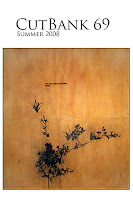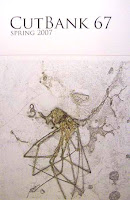
BlazeVOX [books], 2007
Reviewed by Brandi Homan
The title poem from Amy King’s I’m The Man Who Loves You serves as an example of one of King’s true strengths: her confidence. She says:
I began this day by celebrating the hour of my conception
and a simultaneous abandonment of complete non-existence; (34)
Such self-confidence is evident throughout the rest of the work as well, but let’s be clear that it is not arrogance, either unearned or earned—it’s exuberance. King has an unabashed willingness to abandon “non-existence,” to claim her space in the world. “She won’t adhere / to personal space. / She won’t appear / as a potted plant” (71).
As we continue to wade through the aftermath resulting from Chicago Review’s recent articles questioning the nature of the relationship between gender and (especially “experimental” or “avant-garde”) poetry, King’s desire to dive in and both embrace and upend traditional gender roles is refreshing. She continues:
I put on my long black dream and stepped into the world of women
to live among my female brothers who know how to grow
up on ink that occasionally vanishes & candles that eat at the wick;
(34)
The choice of the phrase “female brothers” presents readers with a quandary—Is King intentionally playing with the notion that feminism has been accused of trying to give women “masculine” traits in order to ascertain status? Why not “sisters”? Or is she self-consciously attempting to feminize male writers by assigning their fraternity the “female” title? Instead, the compounding of the two words draws attention to the ever-confusing, and ultimately failing, terminology surrounding gender roles, here specifically among artists.
As much as King, throughout, urges us (and in the previous quote, women writers in particular) to step forward and accept our lives and ourselves, she does so in a way that is disarmingly inclusive, reminding us to “Be small, o person” (74). She looks at our species with a beneficent eye, saying “…it’s amazing how children never quite come to resemble / their grown-up-middle-aged bodies” (64). While these lines could be interpreted as simply name-calling (adults behaving like children), the phrasing suggests that we are, at our most basic, children who should be looked upon with kindness stemming from that very fact—much like how we view our own children. Not that this tendency toward compassion is surprising from King, consider the community-building work that she does with the well-recognized online journal, MiPOesias.
Yet King is not naïve about the relentless potential for expanse (resulting from both human nature and the advent of the digital age) and cruelty that lies between humans in contemporary society:
… The smallest story of two people coming
Together imitates a circus tent in winter holding
Everyone beneath it. (15)
Here, King is acknowledging the “infinite distances” between even the closest people that Rilke has referred to, continuing on elsewhere to complicate the shakiness of relationships further by bringing in that which has the utmost potential for disembodiment: technology.
In his book Some Ether, Nick Flynn refers to the term “Angelization” (coined by Marshall McLuhan), which Flynn describes as “the process / by which any technology disembodies us.” King addresses this erosion several times throughout I’m The Man Who Loves You, compiling examples of answering machines, cables, hybrid vehicles, and digital photos, as in the following:
…I’m attaching a computer-shot photograph
so you know what I mean or can at least see
a pixilated version of my face as it thinks
your name… (77)
King brings the two ideas together—the instability of our relations with one another resulting from nature as well as technology—in phrases like:
…Someone should study
The extracting power one has with another: only everything’s
A signal when you turn your radar on. (15)
I’m The Man Who Loves You is just such a study, with just such a predicament. With so much happening so fast, so often, in today’s society, how are we to determine which signals ultimately have meaning?
King’s underlying compassion does not, however, keep her from being sharp-nosed about the state of the world and our country. In a book filled with highly charged, subversive political commentary, she knows what we’re up against:
…Ultimately, what
is this for—what is it: days of finger clipping,
an elbow of personal risk to maintain state-wide
funding, and a gun using things
you love against you. (56)
But King’s promotion of self and species—plus her slant toward the political—are big-picture issues, and I’m The Man Who Loves You provides many more concrete lyrical pleasures. The book is varied, from often startling word choices to the different lengths/styles/subjects King employs. I’m The Man Who Loves You is organized alphabetically, which is potentially a risk; however, because the work itself takes so many risks, leaps, this choice seems congruent with the scope of her project.
Juxtaposed with outlandish detail, her declarative, assertive moments work well, keeping the poems from being too tongue-in-cheek or abstract. Similarly, moments of mini-narrative help keep readers grounded. Her blunt, apt titles are thoroughly enjoyable (a few favorites being “I’ve Only Got One of Me in Here” and “Yes, You”). She also frequently plays with sound, as evidenced by these lines from “On the Way to Dinner, An Objective Remark Written Down,” combining sibilance, alliteration, and assonance into a veritable aural bouquet:
…A cunning clay
can, a little pan, red devil hot pulp kiss and then the gin’s
sheen lipped across your streaming teeth slips back lick. (53)
Even though King does something that there should be more of in contemporary poetry—addresses the sociopolitical aspects of life in the 21st century head on—I’m The Man Who Loves You accomplishes much more. It is disjointed, beautifully grotesque, and unsparing, yet it is ultimately hopeful, kind, and entertaining. In “I Used to Be Amy King,” King says, “…we are bred to be the best neglected fun, forthcoming” (32). Believe you me, King is this type of fun. I’m The Man Who Loves You is not to be neglected. This book is for anyone who has ever stepped into, or wanted to step into, their own “long black dream.”
**
Amy King is the author of I’m The Man Who Loves You and Antidotes for an Alibi, both from Blazevox Books, The People Instruments (Pavement Saw Press), and most recently, Kiss Me With the Mouth of Your Country (Dusie Press). She is the editor of the Poetics List, sponsored by The Electronic Poetry Center (SUNY-Buffalo/University of Pennsylvania) and teaches English and Creative Writing at SUNY Nassau Community College. Her poems have been nominated for several Pushcart Prizes, and she has been the recipient of a MacArthur Scholarship for Poetry. Amy King was also the 2007 Poet Laureate of the Blogosphere. She is currently editing an anthology, The Urban Poetic, forthcoming from Factory School.
**
Brandi Homan is the author of Hard Reds, forthcoming from Shearsman Books in September, and Two Kinds of Arson, a chapbook from dancing girl press. She is editor-in-chief of Switchback Books.





